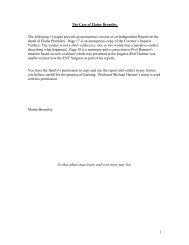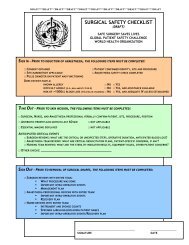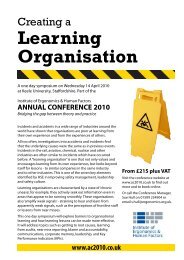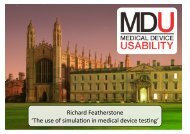The Essentials of Patient Safety - Clinical Human Factors Group
The Essentials of Patient Safety - Clinical Human Factors Group
The Essentials of Patient Safety - Clinical Human Factors Group
You also want an ePaper? Increase the reach of your titles
YUMPU automatically turns print PDFs into web optimized ePapers that Google loves.
<strong>The</strong> <strong>Essentials</strong> <strong>of</strong> <strong>Patient</strong> <strong>Safety</strong><br />
<br />
<br />
<br />
<br />
<br />
Acknowledge error. <strong>The</strong> potential for error in medicine, as in other activities,<br />
needs to be recognized and openly acknowledged. Education about the ubiquity<br />
<strong>of</strong> error, its causes and likely consequences, would promote a more realistic<br />
attitude and constructive approach.<br />
Openness about error. Open discussion <strong>of</strong> error, particularly by respected senior<br />
figures, is very powerful because it provides a mandate for such discussions to<br />
occur at other times. In effect, the junior nurse or doctor learns that it is<br />
acceptable to discuss errors openly because their seniors do it.<br />
Open disclosure. An agreed policy on openness is a critical for staff as for<br />
patients. Many staff are still torn between their own desire for a more open<br />
stance and the more cautious approach that they perceive to be demanded, rightly<br />
or wrongly by managers and colleagues.<br />
Training in disclosure. Training in disclosing and explaining error is critical.<br />
Facing a patient harmed by treatment, or their naturally distressed and angry<br />
relatives, is a particularly difficult clinical situation for which little guidance or<br />
training is available. Both patients and staff will benefit if clinical staff have<br />
some training in helping dissatisfied, distressed, or injured patients and their<br />
relatives.<br />
Formal and informal support. Understanding and acceptance from colleagues is<br />
always important but sometimes people need more than general support and<br />
expressions <strong>of</strong> confidence. <strong>The</strong> range <strong>of</strong> potential support extends from a quiet<br />
word in a corridor to the <strong>of</strong>fer <strong>of</strong> extended psychotherapy. Sometimes a private<br />
discussion with a colleague or a senior figure will be sufficient; some hospitals<br />
employ recently retired senior doctors as mentors.<br />
Few organisations however have put staff support service into practice in an organised<br />
and effective way or fully understood the need for such a service. Brigham and<br />
<br />
both patient and staff support that has its origins in a near disaster in 1999 in which<br />
Linda Kenney, the founder <strong>of</strong> Medically Induced Trauma Support Services, experienced<br />
a grand mal seizure during an operation. Linda Kenney and Frederick van Pelt, the<br />
anaesthetist involved, began in parallel to establish support services for patients and a<br />
peer support programme for clinical staff. <strong>The</strong> staff support programme aims to<br />
recruit credible, experienced clinical staff with personal understanding <strong>of</strong> the impact<br />
<strong>of</strong> error who are immediately available to provide confidential reflection and support.<br />
In addition to an active commitment to disclosure and apology, Brigham and<br />
Hospital has started to develop an Early Support Activation (ESA) with<br />
MITSS for patients and families in conjunction with <br />
social services and patient relations. <strong>The</strong> long-term strategy is to have a<br />
comprehensive emotional support response for patients, families and care providers<br />
(9).<br />
41








